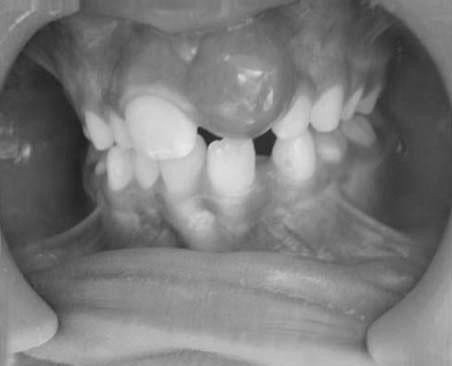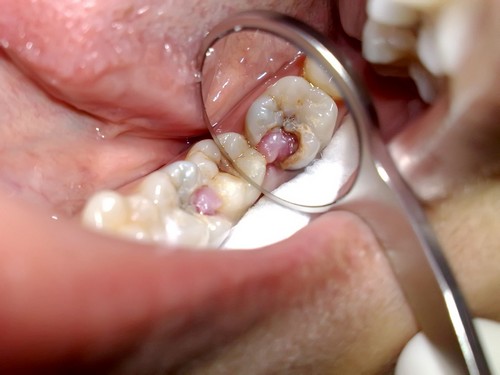Cyst of the tooth is of relatively large size compared to the granuloma and the cyst is a common outcome of inflammatory processes that occur in the region of the tooth root, bruised by the education. In its form dental cyst similar to a capsule inside it accumulates inflammatory content, or exudate. The cause of the cyst may be the transfer of a trauma patient or an infectious process.
Tooth cyst is a benign tumor with a cavity in the majority of cases occur near the apex of the affected tooth. Cavity formation filled with fluid, over time, displacing the healthy dental tissues.
The cyst grows fast enough, so to save the tooth, you should immediately take action and contact your dentist. Dental cyst has a characteristic clinical picture, therefore, its diagnosis is not particularly difficult for a qualified dental specialist.
The body localizes the inflammatory process associated with dental cyst, which is manifested by formation of a dense shell around the dead tissue. This sheath provides insulation undamaged tissues against progression of the infection process. Size of capsule dental cysts start from 0.5 inches, but can grow to several centimeters. According to experts, the capsule size to 0.5 cm defines the lesion as a granuloma and a marked increase in the capsule size like a cyst.
IMPORTANT: remove the tooth and cyst is done only in the most extreme case, when there is a strong destruction of the tooth crown or root in the cavity of the cyst. In other cases, specialists tend to have surgical procedures in order to save the tooth.
Experts distinguish the following varieties of cysts of the teeth for reasons of appearance:
- Cyst eruption. In most cases it appears in children 7-10 years;
- Parentalia, or retromolar, cyst. Occurs when it is difficult eruption of a wisdom tooth or inflammation in the chronic form;
- Follicular or dontogenous, the cyst. Occurs in case of infection of the embryo or reportaugust supernumerary tooth;
- Radicular cyst. Formed on the tooth root, usually develops due to the chronic periodontitis;
- The primary cyst. Appears from the remnants of fabric forming the tooth, in the case of disturbed tooth development;
- Residual cyst. Occurs in the bone after tooth removal.

According to experts, there are following reasons for the development of cyst:
- Tooth trauma;
- Chronic nasal disease, for example, tonsillitis, rhinitis, sinusitis;
- A weakened immune system;
- Periodontitis is an inflammatory process affecting the periodontium – the surrounding tissues of the tooth;
- Infection of the root canal in the course of poor dental treatment;
- Dental caries;
- Difficult eruption of the wisdom tooth;
- Periodontitis is an inflammatory process affecting the periodontium – connective tissue surrounding the root of a tooth in the area of its top;
- Inflammation under the crown of the tooth in the chronic stage;
- Pulpitis is an inflammatory process that attacks the nerve bundle of the tooth.
Dentists emit a serious cause of granulomas is poorly performed filling dental root canals during treatment of pulpitis or periodontitis, leading to inadequate filling of the root canal of the tooth. In the apex of a tooth root remains a cavity in which there are ideal conditions for the emergence of pathogenic microorganisms.
According to experts, the emergence of dental cysts exposed to adults and children. Some children, especially in infancy, dentists identify the nodes bona – milk teeth affected by purulent cysts, and cysts appear near the dairy, and later, permanent teeth. In the end, these cysts can lead to the appearance of tumors.
Interestingly, cysts in newborns of error may be taken by the teeth passing through the process of teething. To avoid such medical malpractice should seek the advice and assistance of only qualified professionals who know what cysts often have a whitish hue and unchanged dimensions of the hearth. Special treatment these cysts do not require their deletion occurs spontaneously in the process of friction of the gums.
The symptoms of cysts of the tooth
Often the development of a dental cyst can occur without symptoms or with almost imperceptible clinical manifestations in the form of rare mild pain when biting on the affected tooth or pressing on the area of the gums. In this case there is only one way of identifying a tooth cyst radiography. According to experts, there is sometimes accidental detection of dental cysts in the course of treatment of other teeth.
The basic symptoms of the cyst in many cases makes itself known at a late stage of its development.
Experts list the following basic symptoms of cyst:
- Pulling or aching pain, often increasing. It is virtually impossible to eliminate using traditional recipes and common analgesics. Initially the patient may feel pain when chewing on the affected tooth;
- The appearance of puffiness. On the gums of the affected tooth cyst – swelling and redness;
- The fevercaused by infectious process. In the cavity of education are pathogens entering into the struggle with the patient. This provokes the appearance of an elevated body temperature and symptoms of General malaise. To eliminate the infection antibiotics are used;
- Headaches. They are characteristic of cysts developing in the maxillary sinus;
- Fistulous course, flux, the appearance of suppuration. Are typical outward signs of fully formed cysts of the tooth.
It is understood that, in times of weakening of the immune system of the patient, for example, on the background of respiratory and catarrhal diseases, infection in the cavity of education enters into an acute phase and causes the formation of pus. This can lead to pain in the affected area, even if there are no manifestations of dental cysts. Despite this, after the soreness may begin to manifest all possible symptoms of cysts of the tooth.
Diagnosis of cysts of the tooth
The diagnosis of radicular dental cysts in most cases does not cause dentist no problems. During the diagnosis carried out x-ray, through which is revealed a rounded area with precise contours and enough pronounced bone pattern. The cyst may be tangent to the apex of the tooth root, but sometimes surrounds him. If on the radiograph at the outlines of the capsule are overlapped image of the roots of nearby teeth, it is necessary to ensure the integrity of the periodontal slit data teeth. If the doctor detects violation of its integrity, it is obvious that the structure of this education involved the teeth located near the affected tooth cyst.
If the integrity of the periodontal gap is not broken, the teeth are not involved with the cystic structure, and image data of the teeth on the background of formation arises from the projection of the bulk of the jaw structure to the film plane for x-ray machine.
Differential diagnosis of cysts of the tooth root is held with oncological diseases and neokonchennyi jaw cysts. You should know that neokonchennaya cyst of the jaw affects the body and not the alveolar process, so it has no connection with tooth root. To differentiate cysts with cancer is the study of the elements of the capsule and fluid.
Cyst after tooth extraction
It happens that after tooth removal, the formation of the cyst. Most often it is caused by the dentist during manipulation using non-sterile instruments and placed in the impact area of the infection. For the prevention of infection and the appearance of the cyst after tooth extraction specialist should give the patient receiving antibiotic drugs, is able to eliminate possible infection. Unfortunately, antibiotics are not able to fully protect the patient from the emergence of infections in the body, and a cyst arising after tooth removal, like any other cyst difficult to diagnose in the initial stage due to lack or absence of clinical signs of this education.

Basic symptoms of cysts appear after its expansion to a considerable amount, according to experts, one of its main symptoms is periostitis – inflammation of periosteum.
In the event of any of the symptoms of cyst after tooth extraction should immediately visit the dentist for examination and diagnosis. Even after tooth extraction there is a risk of spread of the cyst with involvement in the pathological process of healthy teeth.
If the dentist found a cyst under the recently remote tooth, this does not mean that necessarily require the removal of surrounding teeth. Perhaps a specialist will solve the problem of a small intervention – incision of the gums, drainage and the removal of the school.
Complications of cyst
Not diagnosed and not diagnosed in time teeth cysts increase in size and cause destruction of bone tissue with subsequent replacement by connective tissue. At this stage problems can be complications that will lead to future tooth loss.
According to experts, in the presence of a dental cyst can occur with the following pathology:
- Inflammation of the lymph nodes;
- Purulent cystic inflammation;
- The melting of the jaw bone because of the increase in size of cysts;
- The occurrence of periostitis or osteomyelitis due to chronic inflammation of the cysts;
- The occurrence of sinusitis in the chronic form due to cystic growth into the maxillary sinus;
- The occurrence of abscess in the cheeks or gums because of purulent inflammation;
- The formation of a blood infection – sepsis;
- The appearance of cellulitis in the neck area because of the prolonged purulent inflammation;
- Spontaneous jaw fractures occurring due to cystic expansion and thinning of the bone base of the jaws.
If a dental cyst is diagnosed, the patient informs the physician about the presence of purulent odour in the nose, it may mean the beginning of a purulent inflammation or germination unpleasant education in the area of the maxillary sinuses.
Treatment
Treatment of dental cysts involves antiseptic treatment planned manipulations, cleaning the affected tooth and its filling. The alternative medical treatment of cysts of the tooth – the introduction into the canal of the tooth root copper-calcium suspension with a subsequent impact on his low-power electric current.
Treatment of cysts of the tooth, according to experts, is effective in the following cases:
- Poor fillings root canal of a tooth along its length;
- The size of the cyst diameter not exceeding 8 mm;
- The lack of seals on the canals of the tooth root, requiring unsealing.
Cleaning canal treatment
Treatment usually takes several visits dentist, medication can last for months. The first step is to carry out the unsealing of root canals of the tooth, if seals are not available, the technician removes the dental pulp. After that is done cleaning and thorough washing of root canals with disinfectants. For this purpose, can be used solutions on the basis of resorcinol, formaldehyde, chlorhexidine.
Next, with the help of special medical instruments the dentist is cleaning and disinfection of the cavity of the dental cyst, followed by the installation of temporary filling of antiseptic paste. After long months of renewed cleansing and root canal treatment, the process is monitored by regular radiographs. After reducing the size of the cyst and minimize symptoms of education is the installation of permanent seal. Within 12 months after that experts recommend to perform regular x-rays to control the healing process of the lesion cyst.
IMPORTANT: Often the development of a dental cyst can occur without symptoms or with almost imperceptible clinical manifestations in the form of rare mild pain when biting on the affected tooth or pressing on the area of the gums. In this case there is only one way of identifying a tooth cyst radiography.
Depoforez
Depoforez conservative methods of treatment of dental cysts, promote the penetration of active substances in the field of the education that is not available for the tool the dentist. It involves an introduction to advanced instrumental channel of the affected tooth cyst suspension containing calcium hydroxide and copper, with subsequent delivery to the area of low-power manipulation of the current. It contributes to substances in dental channels before reaching the cavity of the cyst for the purpose of disinfection after dental filling.
Treatment of cysts of the tooth with laser
Laser treatment allows to remove a cyst of the tooth without the mess and pain. Treatment dental cyst laser helps to eliminate the formation and disinfection of the affected area. After the laser treatment, there is a rapid healing of wounds with minimal complications.
The laser treatment involves the following stages:
- The unsealing of the tooth, the instrumental opening and enlargement of the root canals;
- Introduction to advanced root canals laser;
- Disinfection of the affected area and elimination of the cyst with a laser.
Positive aspects of laser treatment of dental cysts:
- High-quality disinfection of the affected area;
- No pain;
- Inability to infection due to the contactless treatment;
- The ability to save the tooth without any deletions of its elements;
- Rapid recovery and lack of subsequent complications.
Negative aspects of laser treatment of dental cysts:
- The high cost of manipulation;
- Narrow accessibility equipment for dental laser treatment.
Surgical intervention for the treatment of dental cysts is performed in the following cases:
- The presence of inflammation in the gums;
- The presence of a crown on the affected tooth;
- The presence of the pin in the channel of the tooth root;
- The size of education in the diameter more than 10 mm.
Remove the tooth and cyst is done only in the most extreme case, when there is severe destruction of tooth crown or root in the cavity of the cyst. In other cases, specialists tend to have surgical procedures in order to save the tooth.
Cystectomy
Cystectomy involves the effective, but difficult option for surgical treatment of cysts of the tooth. Cystectomy is mainly prescribed for education is large in size, localized in the maxillary region. During the surgery is the removal of the cyst with the element of the affected root. Sealed in this case, only single-rooted teeth, the remaining teeth are removed.
Cystotomy
Cystotomy involves the removal of the anterior cystic wall with the aim of achieving its message with the cavity of the mouth. Intervention is effective in the case of thinning the jaw bone formations. The disadvantages of the method – long rehabilitation and a high risk of infection.
Hemisection
Hemisection involves removing the affected portion of the root, cysts and damaged crowns. After surgery given oral antibiotic (Ciprofloxacin) and antifungal (Nystatin) preparations for prevention of infection in the area of manipulation. Experts recommend after hemisection apply antiseptics (Orasept, Miramistin), in the presence of pain – painkillers (Solpadein, Ketanov). Swelling can be assigned to a diuretic (Veroshpiron) and desensitizing (Loratadin, Diazolin) drugs.
Folk treatment of cyst
The use of popular recipes, according to experts, it is possible to correct only the symptoms of the cyst, suppress infection in the cyst and relieve the pain, but not for treatment. For relieving the symptoms of dental cysts effective the following recipes:
Salt water. Used for rinsing the mouth, for additional effect, the water with salt you can hold in your mouth. For maximum effect you should dissolve the salt in the infusion of chamomile, calendula, thyme, eucalyptus, hyssop officinalis, horsetail, sage, yarrow. Per Cup of boiling water 2 tablespoons raw materials;
Alcohol infusions and vodka. They are effective in rinsing the mouth when you have a tooth cyst due to the anesthetic and dezinfeciruyuhimi effect of alcohol or vodka. Special effectiveness of different alcohol tincture of horseradish root, for which you need a jar half-filled with raw materials, pour vodka and insist 3 days;
Garlic. For pain relief for dental cyst it is necessary to perform rubbing of the gums from the affected tooth garlic clove. Alternatively, finely chop a clove of garlic and dissolve about half an hour. Garlic phytoncides are released into the bloodstream in the area of the cyst through the mucous membranes of the mouth and suppress the infection;
Rusty nail and honey. Specific, but effective method, especially when complications in the form of suppuration. This requires a rusty nail to heat and dipped in honey. Formed around the nail substance in a dark wash is used to lubricate the gums around the affected tooth.
Tooth cyst in a child – tips for parents
In children cysts teeth do not appear too often, so this problem is not too common. Forums moms often complain that the cyst appears above the not-yet-erupted milk tooth. Experienced parents comfort that this is just a cyst or eruption hematoma is a normal phenomenon. Some do not even have to take their children to the dentist, and the tooth when cut, he breaks through the cyst. Other moms in the forums I advise you to still visit the dentist – the doctor gently opens the cyst, and the teething of the child will be normal.
Sometimes, however, children find the real root of the cyst. In this case, if the tooth is a milky, on the forums it advised to immediately delete – torture the child by cutting the gums and the medications completely useless. But if the tooth is a permanent tooth, then treat the baby just like an adult with cleaning the channels and laying the medication. Experienced parents advise not to be afraid of – pain in the clinics are very good, and your baby won’t be hurt.
Prevention of tooth cysts
- Visiting the dentist twice a year.
- An x-ray when there is any suspicion or symptom of cysts of the tooth;
- Timely removal and treatment of dental and other diseases;
- Thorough and timely oral hygiene;
- Exclusion of the possibility of injury to the teeth or jaw;
- Careful attention to General health, immune.



